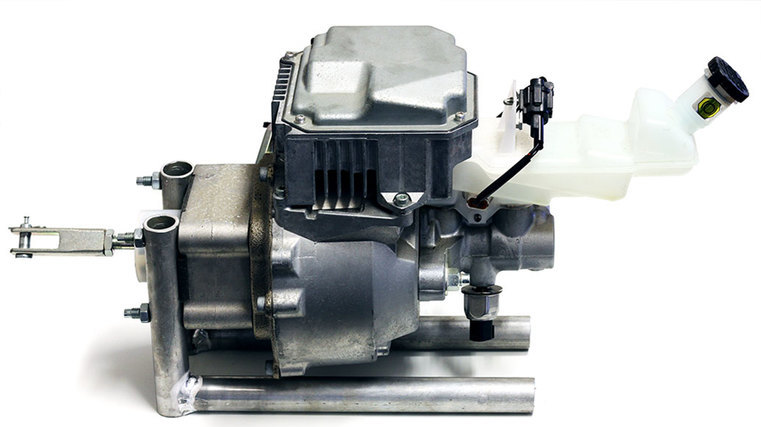Warning over Leaf brakes

Flip the Fleet has received 22 reports of problems with Nissan Leaf brakes, all but one of which occurred in New Zealand, since first raising its concerns about the issue in late November.
The organisation claims nine have resulted from possible firmware faults in the electrically driven intelligent brake-control unit (EDIB) causing brakes to become unresponsive.
It believes there are two states following the EDIB fault – one when impaired but relatively effective braking can still be achieved by engaging the Leaf’s anti-lock braking system (ABS). The second is when the ABS doesn’t engage and the driver halts the vehicle by applying intense pressure on the brake pedal and stopping power is much reduced.
“The same car can exhibit both states of the EDIB fault, but the relative frequency and conditions that trigger the alternate states are unknown,” says Flip The Fleet. “The NZTA has conducted a single test of a Leaf on a roller-brake machine in EDIB fault mode, which appears to have been in the first state, and concluded it meets the warrant of fitness requirements.
“This is encouraging, but we believe further testing is required to evaluate consequences of issues and explore the second impairing braking state that appears to be associated with the ABS not being engaged to help arrest the vehicle.
“If the observed probability of the EDIB fault per car doesn’t change, and if the 2013-16 fleet size continues to double annually, we may expect about 11 such faults over the coming year.”
Flip The Fleet says that in addition to the nine alleged cases with EDIB faults, another 13 instances of a range of braking issues have been reported that don’t appear to relate to the primary EDIB fault being observed. They range from relatively minor to serious events. Many may be solved by recalibrating brake firmware or potentially other maintenance.
“Descriptions of the events leave no doubt of the distress of affected drivers and potential risk and expense involved,” the report states. These include:
• One returning the car to the dealer to buy an internal combustion vehicle instead.
• Another nearly rear-ending a truck, but veered left into an empty lane and turn left again because the traffic light went green at the same time.
• One nearly hitting a rapid-charging station while pulling in to recharge.
• Another ending up in the middle of an intersection.
“Until future monitoring and more extensive research is conducted to better assess and manage any risk, drivers can help protect themselves and others by becoming aware of the potential for faults and what to do if it happens to them,” states the report, which can be found online here.
“Based on our research and testing, we believe in most EDIB fault situations slamming the brake pedal right to the floor and exerting as much force as you can muster may be the most effective way to stop the vehicle.
“If a fault happens to you, use LeafSpy Pro to read the DTCs and ECU versions, accessible via the service menu and send them to Flip The Fleet along with a logbook report. Then take your car to a service agent, preferably a certified Nissan dealer experienced in fixing and servicing Leafs, so they can inspect the ECU and DTC information, and report to Nissan NZ.
“Flip The Fleet is not mandated or equipped to make an overall risk assessment – that’s a job for the NZTA alone.
“Flip The Fleet is urging the NZTA to complete a formal risk assessment and advise answers to three questions. Are the 2013-16 Leafs safe to drive? Are firmware remedies available to fix problems observed here? If a remedy exists, will it be made available at an affordable price for drivers of Leafs imported second-hand into New Zealand?”
Will firmware upgrades reduce risk?
Near the start of this investigation, Flip The Fleet discovered the first case of brake firmware ‘C’ installed on a car from Japan with an unexpected EDIB firmware for that year – for example, 3NG9C was installed on a car that would normally have 3NGxA. Since then, it has found several more examples of this update being completed in Japan.
“We can find no public announcement of the existence of firmware ‘C’ on the 3Nxxx series, a general description of what it does or why it’s being applied to some Leafs in Japan,” says Flip The Fleet.
“In Japan, we understand Nissan’s solution to anyone reporting concerns with brakes on a MY2014/15 car is to complete a firmware update to the relevant ‘C’ version.
“It seems the only recourse for worried owners is to purchase an ‘unofficial’ firmware C upgrade. Flip The Fleet does not endorse this and believes it would be preferable for owners to have the software available through the official dealer network.
“The sooner the NZTA makes a deliberation about the safety of the vehicles, and Nissan clarifies the existence and suitability of any upgrade, the better for everyone.”
What happens next?
Fragmented data available suggests between six and 21 similar EDIB faults will occur in New Zealand next year in 2013-16 Leafs carrying original ‘A’ or ‘B’ firmware, assuming increasing numbers of people buy them at the rate observed over the past two years, Flip The Fleet believes.
“This seems like a significant number and worth minimising if remedies can be found. The most critical and urgent need is to understand the causes and remedies for the second [possible] state of the EDIB fault where we surmise the ABS is no longer helping the driver to stop.
“We have insufficient trials or background information to fully understand what causes a secondary fault state, but one of our test cars exhibited both states over a short period of time after the EDIB fault was triggered experimentally.
“The existence of two states [seems] consistent with some of EDIB fault case histories.
“We urge the NZTA and Nissan to investigate further with formal and well-replicated experiments. It seems logical to seek a remedy to eliminate [any] main EDIB fault if firmware is available to fix that first step, but it would also provide added security if reliable initiation of the secondary ABS assist mode can be achieved as well.
“Requests for follow-up information to Flip the Fleet and discussion on EV Facebook support groups underscore owners’ concerns. If New Zealand is to base a large part of its uptake of EVs on second-hand imports, purchasers need to have confidence they are safe and necessary repairs are available.
“We have some indications that suggest Nissan’s latest ‘C’ brake firmware updates may resolve the EDIB fault, but this has not yet been confirmed either by our own testing/analysis, or comments from Nissan [global], Nissan NZ or the NZTA.
“We have also not had confirmation from Nissan NZ whether these updates will be made available to all New Zealand Leaf owners through its dealer network.”
Log onto www.flipthefleet.org/2018/leaf-brakes-failures for Flip The Fleet’s November 2018 report on this issue.
Autofile awaiting replies from the NZTA and Nissan NZ on the matter. However, on November 27 a spokesman for the agency told Radio NZ it had raised concerns with Nissan and had been assured there were no recalls or service campaigns being undertaken.
“We’re aware of concerns relating to incidents highlighted by Flip the Fleet and are investigating them. This will include a trial of Nissan Leaf brake systems in the coming week.
“We are aware of a voluntary service and recall campaign for Nissan Leafs in parts of the US and Canada, and European Nordic countries, where vehicles were being operated in consistently cold conditions of minus 20 Celsius. This issue was resolved by Nissan.”
The NZTA has encouraged Leaf owners to take their cars to a dealer for testing if they have any concerns.





